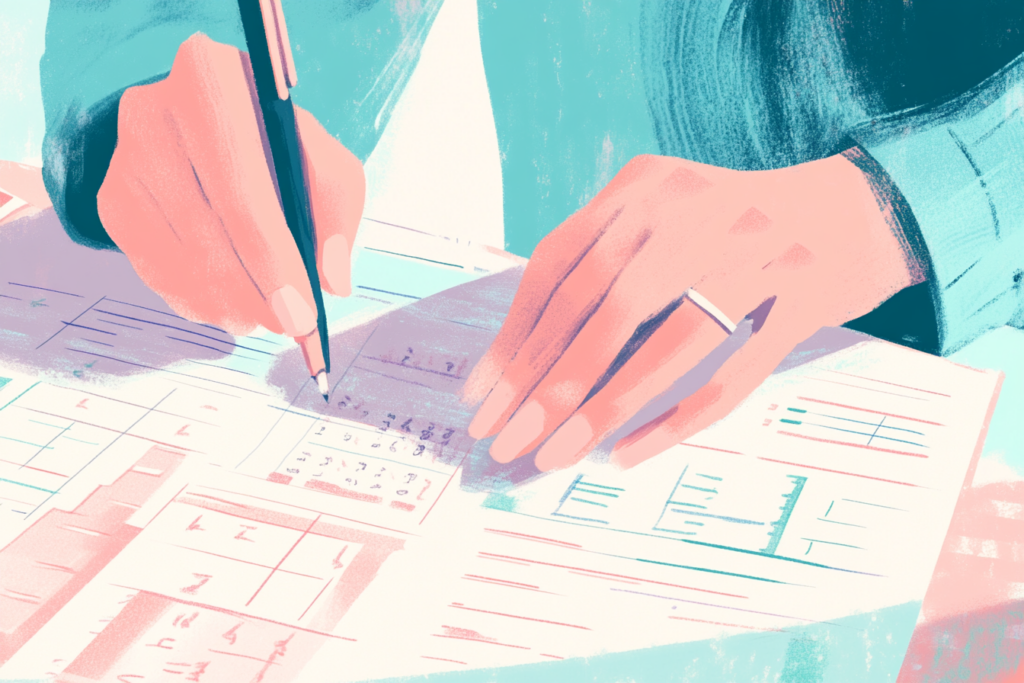Does your paycheck seem to vanish into thin air each month, leaving you wondering where all your money went? You’re not alone. According to a 2024 survey by the Federal Reserve, nearly 35% of Americans don’t track their spending in any meaningful way, and 61% would struggle to cover an unexpected $400 expense.
Enter zero-based budgeting: a powerful financial planning method that transforms your relationship with money by ensuring every dollar has a purpose. Unlike traditional budgeting approaches that often leave money unaccounted for, zero-based budgeting creates complete financial clarity and accountability.
What Is a Zero-Based Budget?
At its core, a zero-based budget follows a simple formula: Income – Expenses = Zero.
This doesn’t mean you’re spending every penny you earn or emptying your bank account each month. Rather, it means you’re intentionally allocating every dollar of your income to specific categories, whether that’s paying bills, reducing debt, building savings, or enjoying entertainment.
Zero-based budgeting is about creating intention with your funds. When every dollar has a job, whether that’s protecting your future through savings or enhancing your present through mindful spending. This approach transforms your financial mindset from reactive to proactive.”
Why Traditional Budgeting Methods Often Fail

Before diving into how to create an effective zero-based budget, it’s worth understanding why many traditional budgeting approaches fall short:
- The 50/30/20 Rule (50% needs, 30% wants, 20% savings) is too rigid for many real-world situations and doesn’t account for debt repayment strategies or varying financial priorities across life stages.
- “Set It and Forget It” Budgeting creates initial awareness but lacks the ongoing engagement needed to adapt to life’s constant changes.
- Tracking-Only Approaches help you see where money went, but don’t proactively guide where it should go.
- App-Based Automatic Categorization often miscategorizes transactions and creates a passive relationship with your finances.
According to a 2024 study in the Journal of Consumer Research, budgets fail primarily because they lack flexibility (37%), don’t align with real-life priorities (29%), or create too much friction to maintain (22%).
The 6-Step Zero-Based Budget Process
Creating a zero-based budget that actually works requires a systematic approach. Here are the six steps to take to make it work for you:
Step 1: Calculate Your Monthly Income
Start by determining your total monthly income, which means all the money you expect to receive during the month.
Include:
- Net pay from your primary job (take-home pay after taxes and deductions)
- Income from side hustles or part-time work
- Regular passive income (rental properties, dividends, etc.)
- Any other predictable monthly income
Step 2: List All Essential Expenses
Begin with your non-negotiable expenses—the bills and necessities that must be paid each month:
Prioritize your four walls:
- Housing (rent/mortgage, property taxes, insurance)
- Utilities (electricity, water, gas, internet)
- Food (groceries, separate from dining out)
- Transportation (car payment, insurance, gas, maintenance)
Then add other essentials:
- Healthcare (insurance premiums, medications)
- Minimum debt payments
- Childcare
- Basic phone service
Step 3: Set Saving and Debt Repayment Goals
Before allocating money to discretionary categories, prioritize financial security and progress:
Emergency Fund: Financial experts now recommend having 3-6 months of essential expenses saved. Aim to build a $1,000 emergency fund before tackling aggressive debt repayment if you’re just starting.
Debt Repayment: Allocate extra money toward high-interest debt. Research shows the “debt avalanche” method (paying highest interest rates first) saves the most money, while the “debt snowball” method (paying smallest balances first) often provides better psychological motivation.
Retirement: Most financial advisors recommend saving 15% of your gross income for retirement through 401(k)s, IRAs, or other retirement vehicles.
Specific Savings Goals: Allocate money toward specific future expenses (home down payment, vacation, car replacement, etc.).
Step 4: Plan for Variable and Discretionary Spending
Now allocate funds for the remaining categories:
- Dining out and entertainment
- Clothing and personal care
- Subscriptions and memberships
- Gifts and donations
- Hobbies and recreation
- Home goods and maintenance
- Miscellaneous expenses
A key insight from behavioral economics: people who explicitly budget for “fun money” are 73% more likely to stick with their overall financial plan than those who try to eliminate all discretionary spending.
Step 5: Balance to Zero
This is where zero-based budgeting differs from other methods. Adjust your categories until:
Income – All Expenses (including savings) = $0
If you have money left over after allocating to all categories, put it toward your current financial priorities:
- Increase debt payments
- Boost emergency savings
- Add to investment accounts
- Enhance quality-of-life spending
If you’re coming up short, you’ll need to:
- Reduce discretionary spending categories
- Find temporary cuts to make the numbers work
- Look for opportunities to increase income
- Reevaluate timing of certain expenses
Step 6: Track, Adjust, and Iterate
Create a system to track your spending throughout the month. The most successful budgeters check their progress weekly (not just monthly).
A 2024 study from the Financial Health Network found that people who check their budget at least weekly are 3.2 times more likely to report improved financial health than those who check monthly or less.
When life happens (and it will):
- Adjust categories as needed during the month
- Move money between discretionary categories
- Learn from overspending to make next month’s budget more realistic
- Celebrate successes, no matter how small
Tools to Support Your Zero-Based Budget
While you can create a zero-based budget with pen and paper, digital tools can simplify the process:
Budget-Specific Apps:
- YNAB (You Need A Budget): Built specifically for zero-based budgeting
- EveryDollar: Simplified zero-based approach with free and paid versions
- Goodbudget: Digital envelope system that works well for zero-based budgeting
Spreadsheet Templates:
- Microsoft Excel and Google Sheets offer free zero-based budget templates
- Customizable for your specific needs and categories
Financial Aggregators:
- Mint and Personal Capital can complement your zero-based budget by automatically tracking transactions
Common Zero-Based Budgeting Challenges and Solutions
Even the best budgeting method comes with challenges. Here’s how to overcome the most common obstacles:
Challenge 1: Variable Income
Solution: Create a “buffer fund” that normalizes your income. During higher-earning months, set aside excess in this fund; during lower months, draw from it to maintain budget consistency.
Challenge 2: Unexpected Expenses
Solution: Include a dedicated “miscellaneous” category (aim for 3-5% of your monthly income) for truly unexpected expenses. For predictable but irregular expenses (car maintenance, medical costs), create sinking funds, small monthly allocations that build up over time.
Challenge 3: Budget Fatigue
Solution: Automate core aspects of your budget. Set up automatic transfers for savings and debt payments on payday. Research from behavioral economics shows that automation increases savings rates by an average of 25%.
Challenge 4: Shared Finances
Solution: Schedule regular money meetings with your partner. Data from the Financial Therapy Association indicates that couples who discuss finances weekly report 68% less financial stress than those who discuss money only during conflicts.
Challenge 5: Forgetfulness
Solution: Use digital receipts and banking notifications. Set up daily balance alerts and spending notifications from your financial institutions to maintain awareness without constant manual tracking.
Making Your Zero-Based Budget Sustainable
The key to long-term success with zero-based budgeting is sustainability. Here are proven strategies to make your budget stick:
Create a Monthly Budget Ritual
Set aside time before each month begins to create your budget. Research shows that Sunday evenings are the most effective time for financial planning, with higher completion rates and lower reported stress.
Schedule Weekly Check-Ins
Brief 15-minute weekly reviews dramatically improve budgeting success. Use this time to:
- Compare actual spending to planned amounts
- Move money between categories as needed
- Make notes for next month’s improvements
Simplify Where Possible
While zero-based budgeting requires more attention than other methods, look for opportunities to streamline:
- Use consistent payment due dates (many creditors will adjust dates upon request)
- Create budget templates you can adjust month to month
- Automate recurring bills and savings
Build in Flexibility and Fun
The most sustainable budgets include:
- Personal spending money with no questions asked
- Occasional splurges within reason
- Room for life’s simple pleasures
A Journal of Consumer Psychology study found that budgets that eliminate all discretionary spending have an 84% failure rate within three months.
Is Zero-Based Budgeting Right for You?
Zero-based budgeting works best for people who:
- Want complete visibility and control over their finances
- Have specific financial goals they’re working toward
- Are willing to spend 1-2 hours per month on financial planning
- Prefer proactive money management to reactive damage control
The Bottom Line: Your Zero-Based Journey
Creating a zero-based budget that actually works isn’t about perfection; it’s about progress. You’ll make mistakes, categories will need adjustment, and life will throw financial curveballs. The power of this system is that it creates a framework for handling financial challenges intentionally rather than reactively.
Start with your next paycheck. Give every dollar a job. Track your progress. Adjust as needed. And watch as your relationship with money transforms from confusion and anxiety to clarity and confidence.
Remember: A budget isn’t about restriction, it’s about creating freedom through intentional choices that align with what matters most to you.
You might also be interested in: Creating a Realistic Budget in 8 Steps


